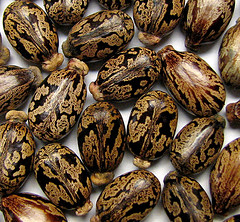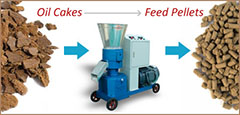Castor Oil Plant Seeds
Castor oil has several commercial application as well. Because it is insoluble in benzine and has a very low freezing point, it is well suited for the lubrication of airplane engines. Castor oil is also used in hydraulic brake fluids and in biodegradable laundry detergents, as well as in paints and varnishes. Oil meant for these purposes is extracted by heat and is poisonous.
 Castor oil plant seeds is the source of castor oil, which has a wide variety of uses. The seeds contain between 40%and 60% oil that is rich in triglycerides, mainly ricinolein. They also contain ricin, a poison, which is also present in lower concentrations throughout the plant.
Castor oil plant seeds is the source of castor oil, which has a wide variety of uses. The seeds contain between 40%and 60% oil that is rich in triglycerides, mainly ricinolein. They also contain ricin, a poison, which is also present in lower concentrations throughout the plant.
The stems and the spherical, spiny seed pods also vary in pigmentation. The pods are more showy than the flowers, the male flowers are yellowish-green with prominent creamy stamens and are carried in ovoid spikes up to 15 cm long; the female flowers, borne at the tips of the spikes, have prominent red stigmas. This variety, IMPALA, has red stems, copper red leaves, yellow flowers and attractive red seed pods!
Castor oil is the oil that comes from castor beans. The castor bean contains 50% to 55% oil. The oil itself contains a lot of fatty acids similar to those used in cooking oil, some examples of this are oleic acid, linoleic acid, stearic acid and palmitic acid.Castor bean plant is probably native to eastern Africa. It is cultivated in hot climates around the world, especially in Africa and southern Asia. The seed capsules are gathered throughout the year when nearly ripe and are then put out in the sun to mature.The castor oil plant, Ricinus communis, is a plant species of the Euphorbiaceae and the sole member of the genus Ricinus and of the subtribe Ricininae. Its seed is the Castor bean which, despite its name, is not a true bean.




Want to set up a mini mustard oil mill of your own ? With the rapid ...
Mustards are part of the oilseed family and are regarded both as a s...
Interested in begin a small size corn oil extraction plant but dont ...
Do you want to make the edible rice bran oil at from using your mill...







